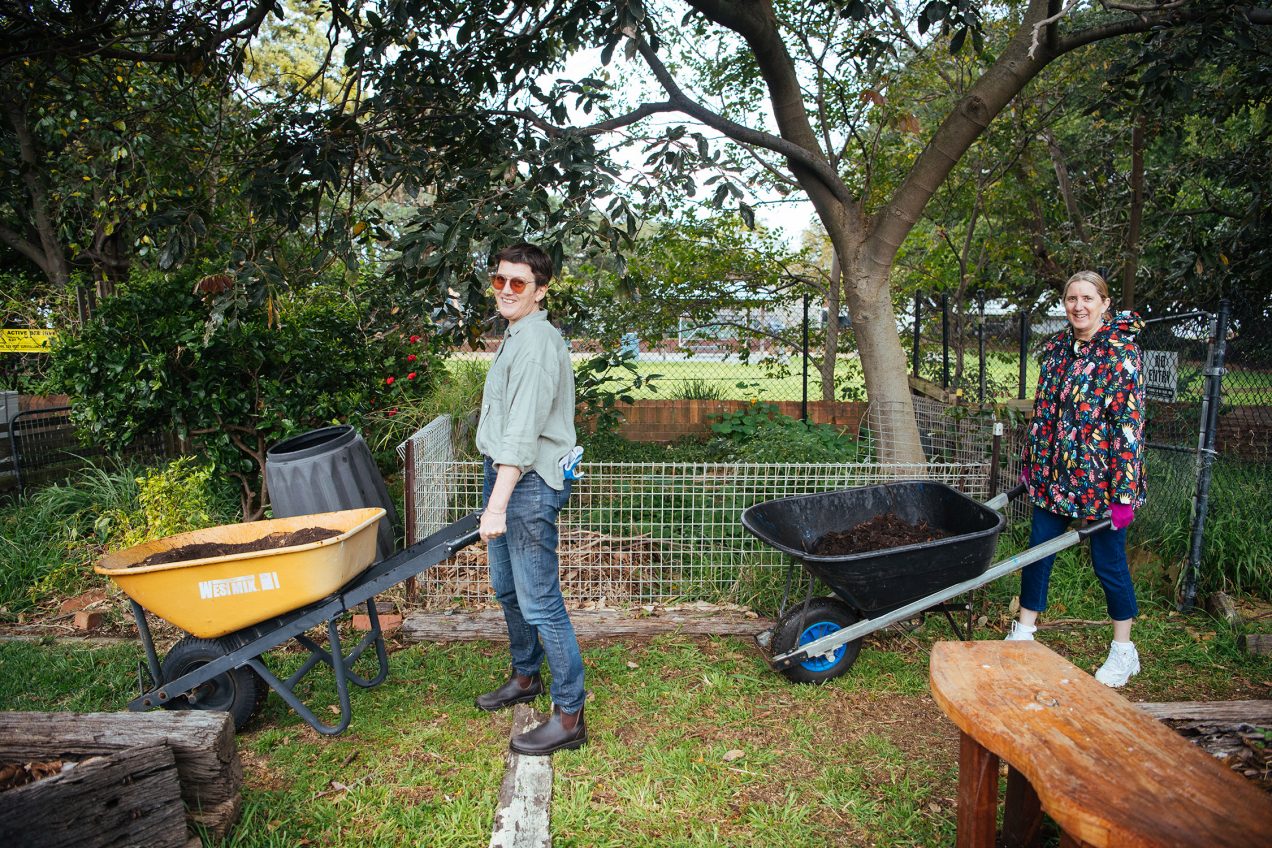The best way to meet people is to turn up to one of our regular working bees. You’re also welcome to spend time in the garden whenever you like. Here’s a bit of guidance for things that always need doing, if you have a minute.
Water the things and refill the ollas
There is a watering can in the greenhouse. Please water all the crop circles and anything else that looks dry. Approximately 2 cans per circle.
To test if something is dry, stick your finger in the soil. If no particles stick to your finger, it needs watering.
The best time to water is before 9am or after 4pm.
There is a roster for watering, but the scheduled waterers may not always have time, so if you have some time, please go ahead and water some.
If you are scheduled to water and someone has already done it, we hope you are happy to share the work and pet the chickens instead!
Plant Seeds
We need new seedlings every week, so if you want to try your hand at raising seeds, please have a go. Note that seed raising is one of the more nuanced gardening skill s you can develop… so its OK and recommended to start by buying your seedlings!
Our introduction to raising seeds.
More on saving seeds.
Our seed library is in a small metal card cabinet in the container.
Prepare annual garden beds
Our annual crops are in circular beds all around the garden. If these are looking tired and empty
- remove any old plants or transplant and consolidate them
- use a spade to slice around the perimeter and pull out any dichondra (liver weed) that has crept in, as well as any other weeds
- spread some compost on top (if the compost is too chunky with woodchips etc, you can sift it)
- mulch with a light medium like finely chopped banna grass (we grow this for mulch), there is a mulcher in the shed. It works best if the bana grass is at least semi-dried so it doesn’t stick together.
Plant out seedlings
Seedlings are ready to plant when they have their second set of true leaves. Make sure you water them ASAFP and cover with a light mulch (wood chips are no good as they will compete with the bebe plants for nitrogen!)
Composting
We make a lot of compost and part of this process includes turning the piles to mix it’s contents and most importantly, to add oxygen and water. It is the adding of oxygen and water that makes the compost heat up, which accelerates the process of decomposition AND cooks any of the annoying weed seeds and roots that we are trying to recycle. Read more about how we compost.
Mulching
If you see soil exposed to the sun, it’s in the process of dying. It forms a crust, repels water and has no living micro organisms in it. Save the soil (and the plants) by spreading mulch!
This stops the sun from hitting the soil- retaining moisture and conditions for life! Something light like small dry leaves, straw or sugar cane around annuals; or aged wood chips and leaves around trees. We are growing Leafy Cardamom, Banna Grass and Arrow Root as renewable, in-situ mulch sources! Bring or borrow some garden scissors or secateurs and chop this stuff up as much as you can be bothered. Woody mulch requires nitrogen to break down and smaller plants cant deal with this nitrogen theft.
Weeds should be pulled out (roots and all) before mulching. Don’t use weed matting, Weed Matting Sux.
Mowing & Trimming
You know what to do! Byo power-tools and get cracking. Please take care around trees and plants. Thanks!
Stockpiling Leaves, Sticks & Weeds
Collect dead leaves and pile them near the compost. We’re making a lot of compost and that requires a lot of carbon content (brown stuff) to be on hand to the person layering the compost. Help this process run smoothly by making sure there is always a pile of dead leaves, right near the compost bays. Grab a rake and a wheel barrow and go for a walk around. There are normally great piles under the fig trees. Fallen leafy branches can also be disposed of this way by chopping them up- 3 jobs done at once!
Weeding
At the time of writing, there are many areas of the garden that are over run with weeds. Do not distress! Start in the area with the least weeds and work outwards. This will stop the weeds from taking back any ground. Be conscious of any seed heads that may distribute seeds into the ground as you’re pulling them out!
One year seeding, seven years weeding
If you can’t identify the plant, best leave it. Here some of our most unwanted weeds to get you started.
Tidy up
We get a lot of plastic bags that blow in from the can collection point near by (every week actually!). This job normally falls on the coordinator of the garden or the volunteers from the club who collect them and take them to the supermarket themselves.
Similarly broken glass, rubbish and boxes of household items that neighbors have “donated”. Any extra help in managing this stuff is greatly appreciated.
There is no bin at the garden, if you have the capacity to take some home that would be appreciated.
Have a Chat
One of our objectives is to help people meet and get to know each other. So have a yarn with someone.
Thank you!
All these things get noticed. Aside from the obvious benefit of having the job done, we all get a massive boost of energy from knowing that there are other people working together to make our garden nice. See you in the garden!

